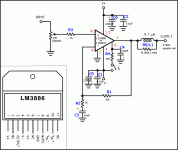Hi all.
I recently (today actually) built an LM3886 gainclone, and it worked fine, uintill the output shorted to ground. Now it doesn't play anymore (no magic smoke or explosions) just silent...It's supposed to be short-to-ground protected? What could be the problem?
Here is the schematic
I recently (today actually) built an LM3886 gainclone, and it worked fine, uintill the output shorted to ground. Now it doesn't play anymore (no magic smoke or explosions) just silent...It's supposed to be short-to-ground protected? What could be the problem?
Here is the schematic
Attachments
If all is ok ,components,fuses and pc board tracks, then the device failed.The specs for output short circuits is based on very short periods.If the short lasted for long ,then the chip is definetly damaged.
I have two circuits like this, is there any way that I can bridge the two or put them in parallel (don't know the difference) To give me an output of about 220W without changing too many things on my 2 PCBs
(the schematic is in my previous post)
(the schematic is in my previous post)
You're not going to get 220W from them no matter what you do - that would require using supply voltages well above what the chip will handle.
You will get double the wattage by using them in bridge mode - but you will only be able to drive 8 ohm loads this way.
If you really want 200W+ then you should be looking at building a discrete amplifier. Chip amps will not get you this kind of power.
You will get double the wattage by using them in bridge mode - but you will only be able to drive 8 ohm loads this way.
If you really want 200W+ then you should be looking at building a discrete amplifier. Chip amps will not get you this kind of power.
I would advise you spend some time researching why you should have installed the stability enhancing components.
Similarly why you should have installed an RF filter at the input and built an AC coupled amplifier.
Similarly why you should have installed an RF filter at the input and built an AC coupled amplifier.
Google BPA-200. It's a National Semiconductor application note describing how to parallel and bridge multiple chip amps. You will also find a few threads on that circuit on this forum. There is also a subsequent BPA-300, if I remember correctly.
I recommend that you read the project from Rod Elliott using the LM3886 and also check his project 14 on a power amp bridging adapter.That will help you understand how bridging works. I have built both circuits and the results are very satisfying
Project 115 - GainCloneGainClone Amplifier
Rod Elliott (ESP)
Project 115 - GainCloneGainClone Amplifier
Rod Elliott (ESP)
If you want to do bridge mode you can simply build one of the LM3886's in an inverting configuration.
The specs for output short circuits is based on very short periods.If the short lasted for long ,then the chip is definetly damaged.
No. Read the data sheet. The LM3886s protection is designed to keep it alive under a short circuit fault condition (if it will only protect it for 0.5s then it isn't short circuit protected) and is tied in with the thermal protection to make sure that the device doesn't over heat whilst under the fault too.
Personally I am with Andrew on this one. A limiter built into the chip isn't going to fail to protect it unless something else was amiss. The short could have very well triggered an oscillation which could have quickly fried something.
No. Read the data sheet. The LM3886s protection is designed to keep it alive under a short circuit fault condition (if it will only protect it for 0.5s then it isn't short circuit protected) and is tied in with the thermal protection to make sure that the device doesn't over heat whilst under the fault too.
Personally I am with Andrew on this one. A limiter built into the chip isn't going to fail to protect it unless something else was amiss. The short could have very well triggered an oscillation which could have quickly fried something.
I did mention that if all is well on the circuit board then the device failed.
Here is a quote from National's Application Note 898 (John deCelles, 1993)
One note to make about this protection scheme is that the
current limitation is not sustained indefinitely. In essence, the
output shorts to ground or either supply rail should not be sustained for
any period of time greater than a few seconds. .
- Status
- Not open for further replies.
- Home
- Amplifiers
- Solid State
- LM3886 REALLY short protected?
